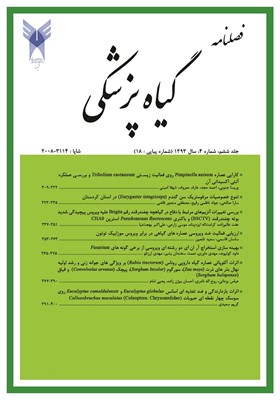Allelopathic effects of medicinal plant madder (Rubia tinctorum) on germination characteristics and seedling growth of sorghum (Sorghum bicolor), corn (Zea mays), field bindweed (Convolvolus arvense) and Johnsongrass (Sorghum halepense)
Subject Areas : Plant ProtectionRuhollah NADERI 1 * , Abbas YAZDANI 2 , Yahya EMAM 3 , Ehsan BIJANZADEH 4
1 -
2 -
3 -
4 -
Keywords:
Abstract :
Excessive use of chemical herbicides has resulted to many problems such as adverse environmental impacts, contamination of groundwater and resistant weeds. Therefore, researchers are looking for solutions to reduce the use of herbicides as more as possible. One effective approach is to use the characteristics of allelopathic plants. To evaluate the allelopathic effects of extracts of madder on seed germination of several crops (corn and sorghum) and weeds (Johnsongrass and field bindweed), four separate laboratory experiments were conducted in 2011 at Yazd University of Applied Science. The experimental design was a completely randomized with 4 replications and 5 treatments. Treatments were madder extract at 5 levels (zero, 25%, 50%, 75% and 100%, respectively). The results showed that the extract of madder could decrease traits such as germination percentage and germination rate, root and shoot length, root to shoot ratio (R / S), seedling vigor index and total dry weight of all plants significantly (p <0.5).Germination percentage of corn and sorghum seeds were not significantly affected up to concentration of 50% and 75% of madder extract, however, germination of weed seeds showed a significant reduction at even lower rates of 25% concentration of madder extract. In general, at concentration of 25 %, germination percentage of filed bindweed and Johnson grass decreased 97 and 95.5 % compared to corn and 96 and 94 % compared to sorghum. Although the extract of madder caused a significant decrease in the rate of germination, root and shoot length, root to shoot ratio, seed vigor index and total dry weight of both crops and weeds, it was found that weeds were more susceptible to madder extract than crops. Results indicated that madder, as a useful medicinal plant, may contain allelochemicals that suppress Johnson grass and field bindweed seedlings growth and could be beneficial for weed control in corn and sorghum crops
Fernandez-Aparicio, M., Emeran, A. A., & Rubiales, D. 2008. Control of Orobanche crenata in legumes intercropped with fenugreek (Trigonella foenum-graecum). Crop Protection, 27: 653–659.
Formanek ,I., & Racz, G. 1975. The antibiotic effect of the madder root (Rubia tinctorium). Pharmazie. 30(9): 617.
Fuji, Y., Furukawa, M., Hayakawara, Y., Sugawara, K. & Shibuya, T. 1991. Survey of Japanese medicinal plants for the detection of allelopathic properties. Weed Research, 36: 36-42.
Iqbal, J., & Wright, D. 1999. Effect of weed competition on flag leaf photosynthesis and grain yield of spring wheat. Agriculture Science, 123: 23-30.
Kato-Noguchi, H. 2003. Assessment of allelopathic potential of shoot powder of lemon balm. Scientia Horticulturae (Amsterdam), 97: 419-423.
Makkizadeh, M, Salimi, M. & Farhoudi, R. 2009. Allelopathic effect of rue (Ruta graveolens L.) on seed germination of three weeds. Iranian Journal of Medicinal and Aromatic Plants, 24,363-471.
Martin, V. L. , McCoy, E.L., & Diek, W. A. 1990. Allelopathy of crop residues influences corn seed germination and early growth. Agronomy Journal, 82:555-560.
Musa nejad, V. & Mirshekari, B. 2008. Allelopathic effect of essence of fennel, cumin and dill weed germination and seedling establishment of pigweed, filed bindweed and nutsedge in greenhouse and laboratory experiment. 18th Iranian Congress of Plant Protection, Iran. P40.
Najafi Ashtiani, A. Assareh, M. H., Baghestani,M.A.&Angaji,S.J. 2008. The Effects of methanolic extract of Eucalyptus camaldulensis Dehnh. on growth and germination rates of Chenopodium album L. Iranian Journal of Medicinal and Aromatic Plants, 24, 293-303.
Rashed mohassel, M. H., Azizi, G., Alimoradi, L., Gharokhlu, J. 2005.Allopathic effect of saffron leaf and Stinking assa on germination of pigweed. 1st National congress of Weeds science. Tehran, Iran.
Samadani, B. & Baghestani, M. 2005. Allelopathic effect of different species of Thyme on seed germination and growth of wild oat. Pajuhesh & Sazandegi. 68. 69-84.
Sandhu, K. S. 1997. Allelopathic interactions of crops. Final technical report. US-India Fund. Ludhiana, India.
Soltanipor, M., Hajebi, A., Dastjerdi, A. & Ebrahimi, S. 2007. Allelopathic effects of aqueous extract of Zhumeria majdae on seed germination of seven species of vegetables. Iranian Journal of Medicinal and Aromatic Plants, 23, 51-58.
Swanton, C. J., Mahoney, K. J., Chandler, K., & Gulden, H., 2008. Integrated Weed Management: Knowledge-Based Weed Management Systems. Weed Science. 56: 168-172.
Tahamizarandi, M. K. & Rezvanimoghadam, P. 2011. Investigation of germination and seedling morphological characteristics of wild oat (Avena ludoviciana) under aqueous extract of the aerial parts of medicinal plants. Crop Protection, 25, 398-406.
Vyvyan, J. R. 2002. Allelochemicals as leads for new herbicides and agrochemicals. Tetrahedron, 58:1631-1646.

